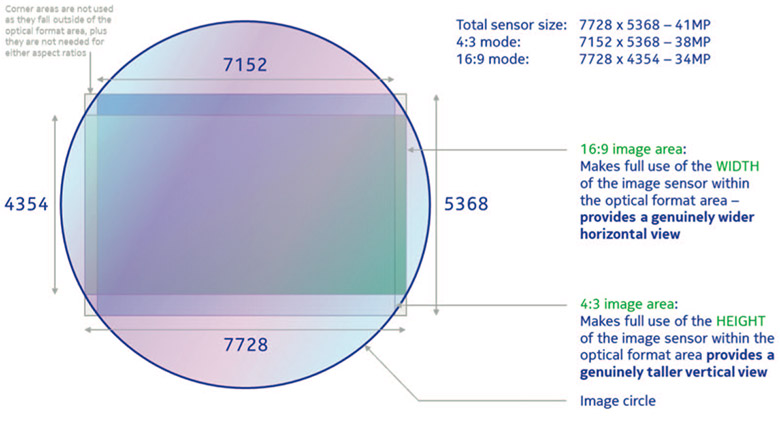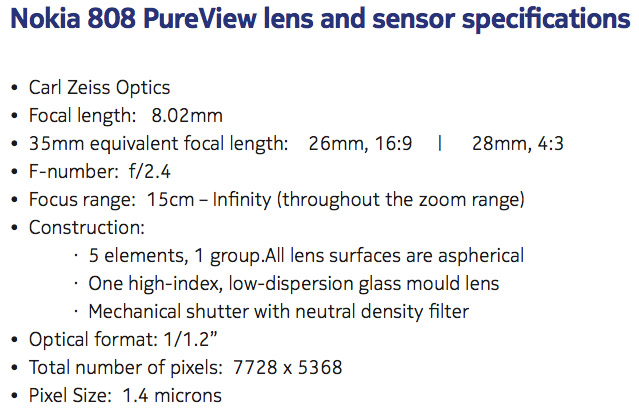
Why Can’t It Take 41-Megapixel Images?
You see, many people will think that “41 megapixels is overkill”, “41 megapixels is useless”, and so on. We’re here to vehemently contradict them, and, after you will understand what Nokia did with this innovation, you will too dream about many many megapixels used in such an extremely useful way.First of all, you can not take 41-megapixel images with the Nokia 808 PureView. “Why not, it has a 41-megapixel sensor, doesn’t it?” Let us look at the sensor of the Nokia 808 PureView. In the image below, you can see a generic five-megapixel sensor in the top left, then a generic eight-megapixel sensor in the middle and the 41-megapixel sensor on the bottom right. Yes, it’s that big, and this explains the hump on the back of the 808 PureView. We’re not talking sub eight-milimeter phones here. Image quality comes at a cost, and thickness is one of them, at least at where today’s technology stands.

You have to think about the sensor and visualize it as being placed on a round circle, called the “image circle”, just as seen in the picture below. Our pictures have an aspect ratio of generally 4:3 or 16:9. While the 41-megapixel sensor in the 808 PureView has a total sensor size of 7728 x 5368 pixels, whenever you take a picture in either of the aforementioned aspect ratios, you will be dropping out some pixels. 4:3 ratio pictures are maxed out at 7152 x 5368 (38-megapixels) and 16:9 images are 7728 x 4354 pixels (34-megapixels). The rest of the pixels are not used but, take a look at the diagram below to visualize the above.

In conclusion, you will be able to take either 38- or 34-megapixel images with the Nokia 808 PureView. So far, nothing out of the ordinary; huge files with huge sizes and lots of pixels, which you will most definitely need to resize since your aim is probably not material for a huge billboard.
How PureView Technology Works
PureView Technology has two main features: 1. image quality and 2. lossless zoom.In terms of image quality, you can take either eight-, five-, or three-megapixel images employing the PureView Technology. For the rest of the article we will only use eight-megapixel examples but the principle applies the same way to five- or two-megapixel photos.
Nokia is using something called “pixel oversampling” which could be misleading, because oversampling in this case doesn’t refer to inflating pixels but creating a so-called “super-pixel”. In case of eight-megapixel images, there’s a ratio of 5 to 1 in creating images (from full size to eight). This picture oversampling combines multiple pixels into a single pixel. The amount of pixels combined depends on the resolution of your final image: eight megapixel images contain super-pixels combined of less pixels than three-megapixel pictures.
To use Nokia’s own description, “you keep virtually all the detail, but filter away visual noise from the image. The speckled, grainy look you tend to get in low-lighting conditions is greatly reduced”.

To put this in a simple context, when you reach the maximum zoom available according to the final image size (eight-, five-, three-megapixels only, zooming is disabled in full-resolution mode) you will basically get a 1:1 crop of the image sensor. At maximum zoom, you will see exactly the image captured by the sensor, with no modifications. Nokia adds: “because only the centre of the optics are used where there is less diffraction, you get better optical performance — including low distortion, no vignetting, and high levels of resolved detail”.
This exact procedure is applied when recording videos. 1080p videos will benefit from 4x lossless zoom by cropping towards 1:1, and 720p videos can zoom to 6x, all in a lossless way.
The Carl Zeiss Optics factor
As if the above wasn’t enough to dramatically improve picture and video quality, Nokia is employing, as usual, Carl Zeiss optics on the 808 PureView, just like pretty much on most of their high-end camera-phones. However, since the 808 PureView is aiming towards being the King of camera phones (stealing that title from the previous model, the Nokia N8), make no mistake that the best Carl Zeiss optics were included. If you’re tech-savvy or a photographer, check out the full specifications of the lens and sensor below.
King of Camera-phones?
With all the features described above (huge sensor, PureView Technology and Carl Zeiss optics), the Nokia 808 PureView is a serious contender to the title. The Finnish manufacturer has no doubt about it and has built the phone to become the standard in phone photography. Judging by the facts on paper, the 808 PureView can easily be crowned as King. However, we’ll make sure to put it to the test in real-life usage to make sure all the tech and marketing talk have a solid basis.Source: YouTube, Nokia




No comments:
Post a Comment